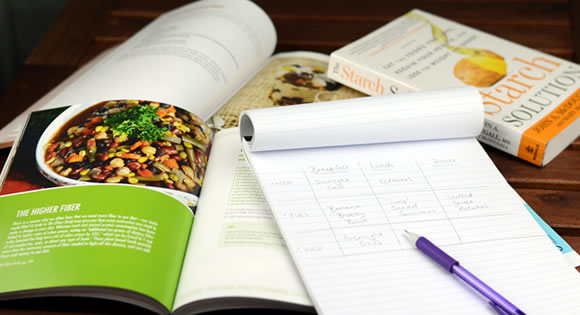Learn how to plan a week's worth of healthy plant-based meals - complete with menu samples to help get you started!

Whether you're catering to a family of 5, or only cooking for one, planning meals for the week ahead is a great way to save time and money.
"How does planning ahead save me time?"
Well, for starters, you won't have to spend any time um-ing and ah-ing in front of the fridge each night! By coordinating your week, you can have leftovers prepared for lunches, enough cooked grains for 3-4 days at a time, and homemade sauces and dressings ready for meals throughout the week. All these things equate to less time spent in the kitchen on a day-to-day basis.
"How can planning ahead save me money?"
This one is simple- because you have a plan, you'll know what exactly what you're shopping for in advance, and will therefore only buy what you need. No more money wasted on convenience foods, or on fresh items that expire or go bad before they get used!
So, how do you plan a weekly menu? You can start by following these seven simple steps:
1. Set aside time to do the planning. Sunday afternoons or Friday evenings are fantastic for menu-planning. Regardless of which day is convenient for you, make sure that it's one or two days before you do your groceries, so that you have time to make a comprehensive shopping list. If you have a partner or a family, they can also be included in the process. Let them pick out one or two recipes they'd like to try for dinner, or have them choose what they'll be eating for breakfast.
2. Don't over-complicate things. Stick with one or two breakfast options, keep lunches quick and easy during the week, and don't plan to make a dinner with 17 different components when you have 20 other things to do that night!
3. Use the same ingredients 2, 3 or 4 times. If you're making black beans for Monday's dinner, use them again in Tuesday’s lunch or Wednesday's dinner. The same goes for grains- if you use brown rice 3 or 4 times during the week, cook all that you need in one batch, and refrigerate the rest. This approach can literally save you hours!
4. Try to make as few grocery trips as possible. Once a week is great if you can, but you may have to go 2 or 3 times depending on your location or living situation. No matter how often you go, be sure to make a list and stick to it! This will help you to avoid impulse buys, which will save you a lot of money in the over the course of the month or year.
5. Make leftovers. Chillies, soups, stews and pastas make great "leftover" lunches, meaning that you don't have to go out of your way to prepare lunch every day.
6. Leave room for a couple of improvised meals. This gives you the freedom to use up what's left at the end of the week, and to avoid wasting food if you end up having to eat away from home.
7. Buy enough food for between meal snacks. If you don't, you'll end up buying them when you're out, and you probably won't make the best choices if you're really hungry! Stock up on fresh fruit, vegetables, brown rice cakes, raw nuts and seeds, or extra legumes for making dips.
If you'd like to see how to put these principles into action, there are 2 examples of menu plans below. Menu 1 is based entirely on recipes; it is more structured, and perfect for those who want to learn to cook complete plant-based meals. Menu 2 is based simply on combinations of ingredients. This allows you to "personalise" you meals and make them as creative or basic as you like.
SAMPLE MENU 1: RECIPE BASED
Monday
Dinner: Quick Spiced Refried Beans (make enough for tomorrow's lunch) + Brown Rice (make enough for tomorrow's lunch) + Salad Vegetables
Tuesday
Wednesday
Thursday
Dinner: Lentil Bolognaise (make enough for tomorrow's lunch) + Salad or Steamed Greens
Friday
Saturday
Dinner: "Throw Together Meal" (use up what's in your fridge)
Sunday
Dinner: 7 Minute Soup (make enough for tomorrow's lunch) + Whole Grain Bread
SAMPLE MENU 2: SIMPLE COMBINATIONS
Add your favourite herbs, spices, sauces or dressings to complete your meals.
Monday
Breakfast: Oatmeal with Fresh Fruit
Lunch: Sweet Potato + Summer Squash + Leafy Greens
Dinner: Chickpeas + Sweet Potato + Leafy Greens
Tuesday
Breakfast: Whole Grain Bread + Nut Butter and Banana
Lunch: Chickpeas + Millet + Summer Squash
Dinner: Millet + Black Beans + Leafy Greens
Wednesday
Breakfast: Oatmeal with Fresh Fruit
Lunch: Black Beans + Sweet Corn + Tomatoes
Dinner: Whole Wheat Pasta + Mushrooms + Tomatoes + Spinach
Thursday:
Breakfast: Whole Grain Bread + Nut Butter and Banana
Lunch: Potato + Lentils + Leafy Greens
Dinner: Brown Rice + Lentils + Carrots + Sweet Corn
Friday
Breakfast: Oatmeal with Fresh Fruit
Lunch: Brown Rice + Kidney Beans + Leafy Greens
Dinner: Kidney Beans + Quinoa + Carrots + Tomatoes
Saturday
Breakfast: Whole Grain Bread + Nut Butter and Banana
Lunch: Quinoa + Beets + Leafy Greens
Dinner: Buckwheat + Mushrooms + Leafy Greens
Sunday
Breakfast: Oatmeal with Fresh Fruit
Lunch: Buckwheat + Beets + Carrots
Dinner: "Throw Together Meal"
Article photo courtesy of shimelle via Flickr
